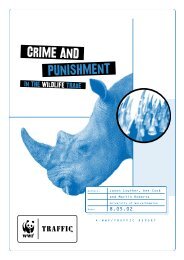In full swing: assessment of trade in orang-utans and ... - WWF UK
In full swing: assessment of trade in orang-utans and ... - WWF UK
In full swing: assessment of trade in orang-utans and ... - WWF UK
Create successful ePaper yourself
Turn your PDF publications into a flip-book with our unique Google optimized e-Paper software.
a number <strong>of</strong> <strong>in</strong>dividuals. To complicate the data-compil<strong>in</strong>g process even further, <strong>in</strong> several <strong>in</strong>stances, <strong>in</strong>formation on<br />
species composition, number <strong>of</strong> <strong>in</strong>dividuals present <strong>and</strong> their orig<strong>in</strong> provided by zoo <strong>of</strong>ficials did not match those given<br />
by the keepers or that what was actually on display <strong>in</strong> the zoos. For such cases, a conservative approach has been taken<br />
<strong>in</strong> this report’s analysis <strong>and</strong> it <strong>in</strong>cludes only those data on which both parties agreed, otherwise <strong>in</strong>formation was pooled<br />
under a more general entry.<br />
Department <strong>of</strong> Forestry<br />
Data on the number <strong>of</strong> confiscated gibbons <strong>and</strong> <strong>orang</strong>-<strong>utans</strong> <strong>in</strong> the last 10 years, the results <strong>of</strong> the legal follow-up <strong>of</strong> these<br />
confiscations, if any, <strong>and</strong> the number <strong>of</strong> pet gibbons <strong>and</strong> <strong>orang</strong>-<strong>utans</strong> registered at their <strong>of</strong>fice, were requested from the<br />
five regional branches <strong>of</strong> the <strong>of</strong>fice for the conservation <strong>of</strong> natural resources (BKSDA), i.e., Greater Jakarta, Bogor-<br />
Sukabumi-Cianjur, DKI Yogyakarta, Surabaya, <strong>and</strong> Bali. None <strong>of</strong> these <strong>of</strong>fices had all these data at their disposal but<br />
all were able to provide at least some <strong>of</strong> the requested data.<br />
Additional data – Literature Searches<br />
The <strong>In</strong>donesian Nature Conservation Database (ma<strong>in</strong>ta<strong>in</strong>ed at the Pusat <strong>In</strong>formasi L<strong>in</strong>gkungan <strong>In</strong>donesia, Bogor) was<br />
searched to f<strong>in</strong>d news items, newspaper articles, etc., that related to the <strong>trade</strong> <strong>in</strong> gibbons <strong>and</strong> <strong>orang</strong>-<strong>utans</strong> on Java <strong>and</strong><br />
Bali. All issues <strong>of</strong> Suara Satwa (circulated by ProFauna) <strong>and</strong> the <strong>In</strong>ternational Primate Protection League Newsletter<br />
were scanned for new <strong>and</strong> relevant data. An <strong>in</strong>ternet search (www.google.com) was conducted with the key words:<br />
“gibbons”, “Hylobates”, “<strong>orang</strong>-<strong>utans</strong>”, “Pongo”, “Java”, “Bali”, “<strong>In</strong>donesia”, <strong>and</strong> “<strong>trade</strong>”, <strong>in</strong> various comb<strong>in</strong>ations, <strong>and</strong><br />
the Web <strong>of</strong> Science (http://isi4.isiknowledge.com/) was consulted to search for scientific reports on the <strong>trade</strong> <strong>in</strong> gibbons<br />
<strong>and</strong> <strong>orang</strong>-<strong>utans</strong>.<br />
Any additional <strong>in</strong>formation <strong>in</strong> the form <strong>of</strong> unpublished reports, unpublished academic theses, <strong>and</strong> unpublished data were<br />
solicited from those <strong>in</strong>dividuals that were most likely to have knowledge <strong>of</strong> the presence <strong>of</strong> these sources. As such,<br />
numerous reports were uncovered <strong>and</strong> these were scanned for relevant data.<br />
Species identification<br />
Because <strong>of</strong> their high <strong>in</strong>tra-specific variability <strong>in</strong> fur coloration (<strong>in</strong>clud<strong>in</strong>g sexual dichromatism, polychromatism, <strong>and</strong><br />
multiple ontogenetic colour changes) <strong>and</strong> the relatively small amount <strong>of</strong> (published) research on the group,<br />
identification <strong>of</strong> gibbons <strong>in</strong> captivity can be problematic (Geissmann, 1995; Chen et al., 2004). Gibbons can be reliably<br />
identified based on vocal characteristics, but only a few people are familiar with the method <strong>and</strong> with<strong>in</strong>-species call<br />
variability (Dahlmann & Geissmann, 2001). To add to the problem <strong>of</strong> species identification, several species <strong>in</strong> the genus<br />
Hylobates hybridize <strong>in</strong> (small) parts <strong>of</strong> their range, or, less commonly, <strong>in</strong> zoos. Given all these difficulties, it is not<br />
uncommon to see gibbon species <strong>in</strong>correctly identified <strong>in</strong> both <strong>In</strong>donesian <strong>and</strong> <strong>in</strong>ternational zoos (Geissmann, 1995; this<br />
study), <strong>and</strong> when assess<strong>in</strong>g the results <strong>of</strong> bird market monitor<strong>in</strong>g programmes, these difficulties <strong>in</strong> species identification<br />
have to be taken <strong>in</strong>to account. The Bornean White-bearded Gibbon H. albibarbis is now generally recognized as a<br />
dist<strong>in</strong>ct species, endemic to the southwestern part <strong>of</strong> Borneo (i.e., the prov<strong>in</strong>ces <strong>of</strong> West <strong>and</strong> Central Kalimantan), but<br />
was previously considered a subspecies <strong>of</strong> the more widely occurr<strong>in</strong>g Agile Gibbon H. agilis from Sumatra <strong>and</strong> various<br />
parts <strong>of</strong> Pen<strong>in</strong>sular Malaysia. <strong>In</strong> almost all <strong>of</strong> the older reports, <strong>and</strong> many <strong>of</strong> the more recent, no dist<strong>in</strong>ction is made<br />
between these two taxa <strong>and</strong> this has to be taken <strong>in</strong>to consideration when analys<strong>in</strong>g data.<br />
Gibbons observed <strong>in</strong> our survey were almost exclusively identified on the basis <strong>of</strong> their morphology, i.e., fur coloration,<br />
body weight, the presence or absence <strong>of</strong> a throat sac, <strong>and</strong> the size <strong>of</strong> the male genital tuft, etc. To make a general<br />
IN FULL SWING:ASSESSMENT OF TRADE IN ORANGUTANS AND GIBBONS ON JAVA AND BALI,INDONESIA 13


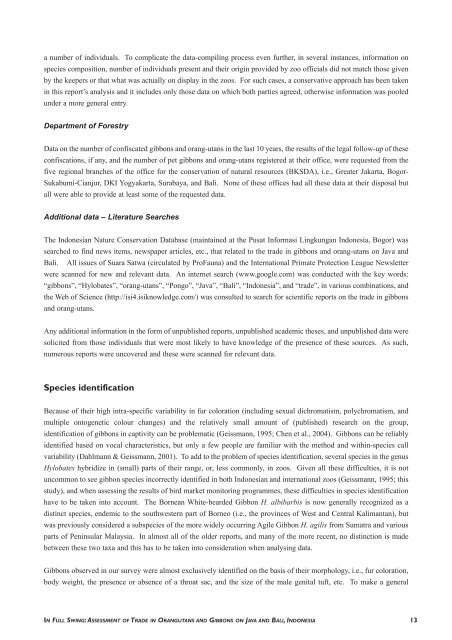
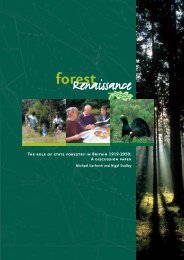
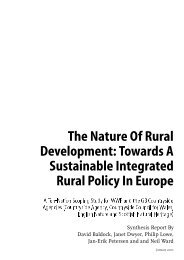
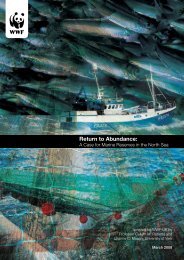

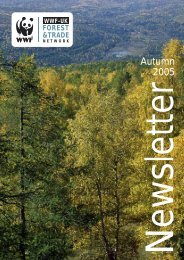

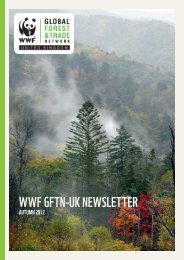
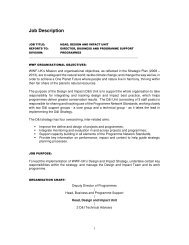
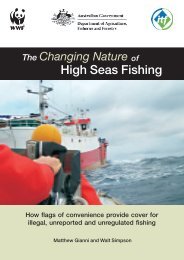
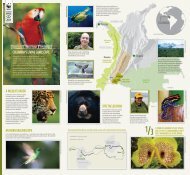
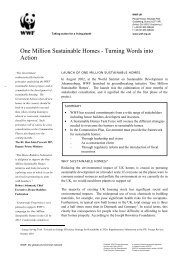
![[PDF] Causes for concern: chemicals and wildlife - WWF UK](https://img.yumpu.com/31929970/1/184x260/pdf-causes-for-concern-chemicals-and-wildlife-wwf-uk.jpg?quality=85)
